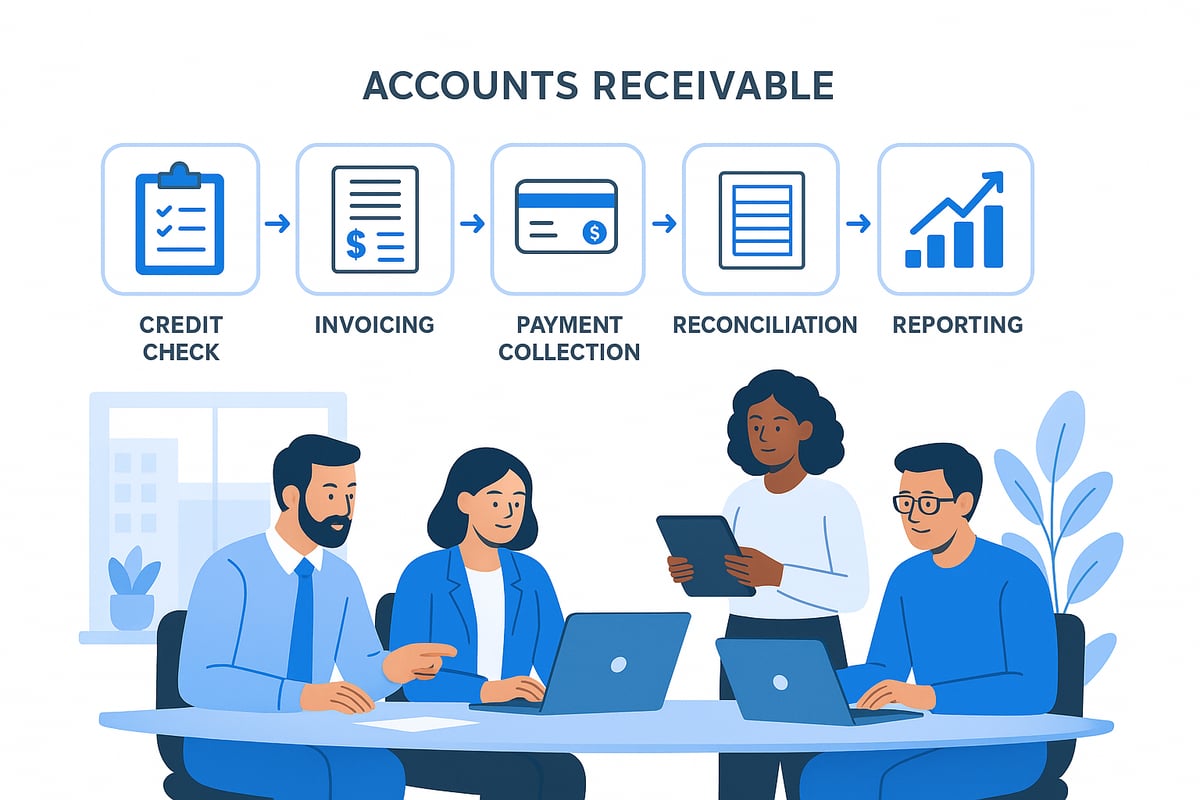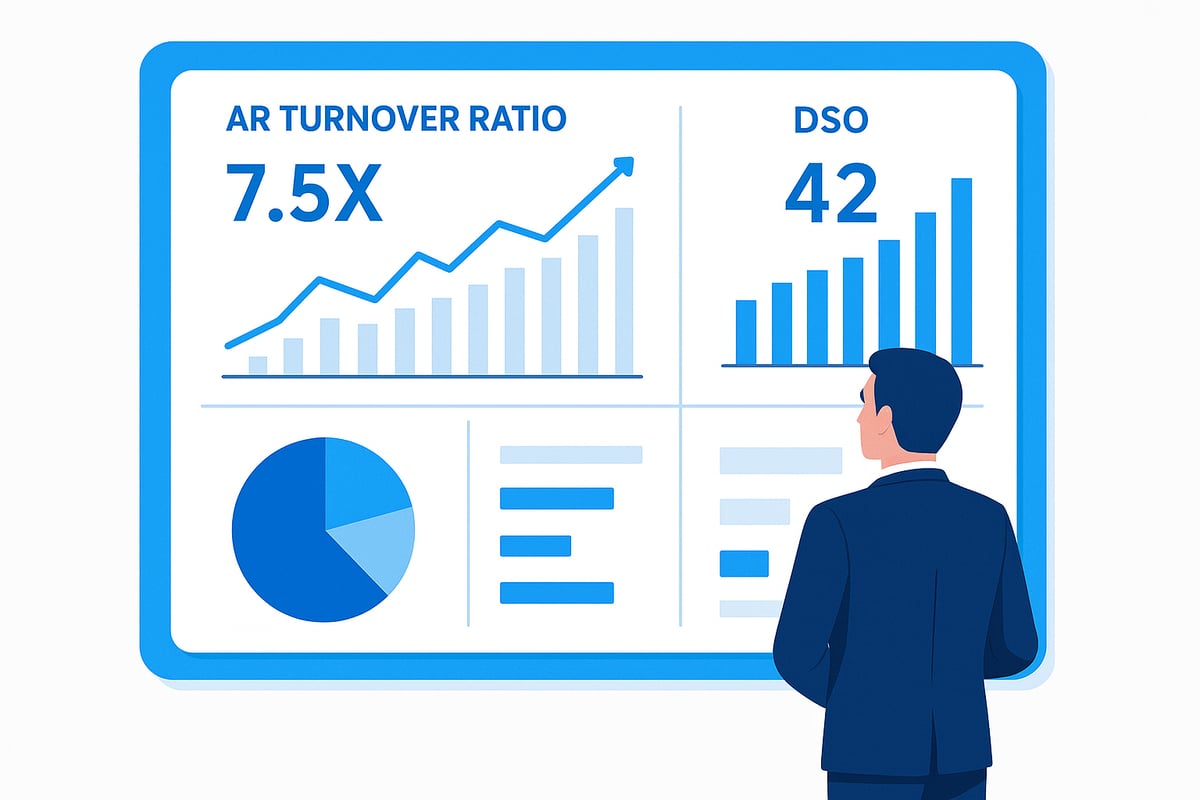Accounts Receivable Guide: Mastering Cash Flow in 2025
In 2025, mastering cash flow is essential for every business aiming to survive and grow in a rapidly changing market. The ability to manage accounts receivable effectively can make the difference between thriving and falling behind. This guide will help you take control of your financial future by presenting proven strategies, updated processes, and the latest technologies for optimizing accounts receivable. You will learn the fundamentals, see how AR influences cash flow, explore step-by-step management, uncover key metrics, discover modern automation tools, and find advanced strategies tailored for 2025. Start now to put these best practices into action and drive your business forward.
Understanding Accounts Receivable: Foundations for Financial Health
In the world of business, accounts receivable are the backbone of short-term financial health. When a company provides goods or services on credit, the resulting unpaid invoices become accounts receivable, recorded as current assets on the balance sheet. For example, when Company A invoices Company B $10,000 for delivered products, that invoice becomes accounts receivable for Company A until it is paid.
Unlike cash sales, which provide immediate funds, accounts receivable often involve payment terms of 30 to 60 days, according to industry data from Taulia. This waiting period is crucial for managing liquidity and working capital. In fact, accounts receivable can represent a significant portion of a firm's working capital, directly impacting how quickly a business can meet its obligations or seize new opportunities. To understand how AR affects a company's ability to pay its short-term liabilities, many finance professionals rely on metrics like the quick ratio and liquidity.

What Are Accounts Receivable?
Accounts receivable refer to money owed to a business by its customers for goods or services delivered on credit. These amounts are listed as current assets on the balance sheet, reflecting their expected conversion into cash within a short period. For instance, if a company issues a $10,000 invoice to a client, that sum appears as accounts receivable until payment is received.
Unlike cash sales, which instantly boost liquidity, accounts receivable involve a waiting period defined by agreed payment terms, typically 30 to 60 days. This time lag means that managing accounts receivable is essential for maintaining healthy cash flow and supporting ongoing operations. Efficient management ensures that working capital is available when needed, helping businesses avoid cash shortages and capitalize on growth opportunities.
Accounts Receivable vs. Accounts Payable
Understanding the distinction between accounts receivable and accounts payable is fundamental for financial clarity. Accounts receivable are assets, representing amounts owed to the business, while accounts payable are liabilities, reflecting what the company owes to suppliers.
Consider this relationship: Company A sells on credit to Company B. For Company A, the transaction creates accounts receivable; for Company B, it results in accounts payable. Both figures appear on their respective balance sheets but have opposite effects. Accounts receivable support liquidity, whereas accounts payable require careful management to maintain good supplier relationships and avoid late fees. Their cycles are interconnected, influencing overall cash flow and financial reporting accuracy.
| Accounts Receivable | Accounts Payable | |
|---|---|---|
| Definition | Money owed to the business | Money the business owes |
| Balance Sheet | Current Asset | Current Liability |
| Impact | Increases liquidity | Decreases liquidity |
The Accounts Receivable Department & Process
Accounts receivable is not only an accounting term but also a key business function. The AR department manages the entire process, including issuing invoices, tracking payments, reconciling accounts, and pursuing overdue balances. Their responsibilities are critical for accurate forecasting and smooth business operations.
Inefficiencies in accounts receivable management can lead to cash flow disruptions, increased defaults, and wasted resources. Without streamlined processes, companies may struggle to collect payments on time, resulting in missed opportunities or even payroll delays. Optimizing the AR process—through timely invoicing, diligent follow-up, and regular reconciliation—strengthens financial stability and positions a business for sustainable growth.
The Impact of Accounts Receivable on Cash Flow in 2025
Mastering accounts receivable is essential for maintaining healthy cash flow in 2025. As businesses navigate rapid economic shifts and evolving customer expectations, the ability to efficiently manage accounts receivable directly affects liquidity, growth opportunities, and overall financial stability.

Why Cash Flow Mastery Matters
Cash flow serves as the financial lifeblood of every organization. When accounts receivable are managed proactively, companies have the resources to pay suppliers, invest in growth, and weather market disruptions. However, delayed collections can create serious cash flow crunches, leaving businesses unable to seize new opportunities or even meet payroll on time.
For instance, if a business experiences slow accounts receivable turnover, it may have to forgo strategic investments or delay hiring. According to Taulia, the speed of AR collection is closely tied to a company's ability to react to market changes. In 2025, economic volatility and tighter lending standards make cash flow mastery even more critical. Businesses that optimize accounts receivable will be better positioned to adapt, compete, and thrive.
Key Cash Flow Metrics Related to AR
To truly understand the impact of accounts receivable on cash flow, organizations must track specific metrics. The Accounts Receivable Turnover Ratio shows how quickly AR is collected, while Days Sales Outstanding (DSO) reveals the average number of days it takes to receive payment. The Cash Conversion Cycle (CCC) provides a broad view of how efficiently cash moves through the business.
| Metric | Definition | Benchmark (varies by industry) |
|---|---|---|
| AR Turnover Ratio | How often AR is collected in a period | 7-12 |
| Days Sales Outstanding (DSO) | Avg. days to collect accounts receivable | 30-45 days |
| Cash Conversion Cycle (CCC) | Time to turn investments into cash | 30-60 days |
Interpreting these numbers helps leaders identify bottlenecks and risks. For deeper insights, reviewing the income statement essentials can clarify how accounts receivable performance affects overall profitability and financial reporting.
Common Cash Flow Challenges Tied to AR
Several challenges can disrupt cash flow when accounts receivable processes are inefficient. Late payments and customer defaults are common, especially in uncertain economic climates. High DSO leads to liquidity gaps, making it harder for businesses to cover their own obligations or invest in growth.
Manual collections consume valuable time and increase the risk of errors. Economic volatility and supply chain disruptions in 2025 may further strain AR cycles. To address these issues, companies can:
- Automate invoicing and reminders
- Offer early payment discounts
- Regularly review credit policies
- Monitor AR aging reports
By proactively managing accounts receivable, organizations can minimize risks and ensure consistent, predictable cash flow.
Step-by-Step: The Modern Accounts Receivable Process
A modern accounts receivable process is essential for maintaining healthy cash flow and supporting business growth in 2025. By following a structured approach, organizations can minimize delays, reduce risk, and maximize efficiency. Let’s break down each step in the accounts receivable journey.

1. Credit Policy Development
Setting up a strong credit policy is the foundation of effective accounts receivable management. Begin by assessing each customer’s creditworthiness using credit scores, payment histories, and references. This helps minimize risk and ensures only reliable clients receive credit terms.
Define clear credit terms, such as 2/10 net 30 or 30/60-day payment periods, and communicate these terms upfront. Establish approval workflows so that high-risk accounts go through additional review. For example, a new client might start with a lower credit limit until they demonstrate prompt payments.
A transparent credit policy keeps both your team and your customers aligned, reducing confusion and disputes. This initial step sets the stage for a streamlined accounts receivable process.
2. Invoicing Best Practices
Accurate and timely invoicing is the heartbeat of accounts receivable. Generate invoices immediately after goods or services are delivered. Ensure all necessary details are included, such as purchase order numbers, payment terms, and due dates.
Digital invoicing is preferred over paper, as it speeds up delivery and reduces human error. Automation tools can send invoices directly to clients, flag missing information, and trigger reminders before due dates. For a deeper dive into automation, explore the Accounts Receivable Automation: The Complete 2025 Guide, which outlines the latest strategies for efficient operations.
By optimizing invoicing, you help your accounts receivable cycle move faster, freeing up cash and resources.
3. Payment Collection Strategies
Collecting payments efficiently is crucial for accounts receivable success. Offer multiple payment options, including ACH transfers, credit cards, and wire payments. This flexibility increases the likelihood of prompt settlement.
Automated payment reminders and follow-ups can reduce the Days Sales Outstanding (DSO). Consider offering early payment discounts, such as 2% off for payments made within 10 days, to encourage faster turnover. Set clear escalation procedures for overdue accounts, such as sending additional reminders or involving your collections team.
These proactive strategies keep your cash flow steady and reduce the risk of cash shortages due to delayed accounts receivable.
4. Reconciliation and Recording Payments
Accurate reconciliation ensures your accounts receivable ledger matches actual payments received. Match each payment to the correct invoice, and promptly address partial or overpayments.
Update your ledgers and cash flow records in real time. Integrating your accounts receivable process with ERP or accounting systems streamlines this task, reduces manual errors, and provides better visibility into your cash position.
Automated reconciliation tools can further simplify this step, ensuring every dollar is accounted for and supporting reliable financial reporting.
5. Managing Delinquencies and Bad Debt
Despite best efforts, some accounts receivable will become overdue. Identify these accounts early using AR aging reports, which categorize outstanding invoices by age.
Implement a structured collections process, starting with reminder calls or emails, then progressing to formal letters or legal action if needed. Establish a bad debt reserve to account for potential losses. In some cases, you may consider factoring or selling delinquent accounts receivable to third parties for immediate liquidity.
Managing delinquencies proactively safeguards your cash flow and limits the impact of non-payment on your business.
6. Reporting and Performance Review
Regularly reviewing accounts receivable performance is vital for continuous improvement. Track key metrics like turnover ratio, DSO, and aging reports to spot trends and identify bottlenecks.
Set clear targets for your AR team and adjust processes based on data insights. Use dashboards and real-time reporting to make informed decisions and enhance cash flow forecasting.
A disciplined review process ensures your accounts receivable strategy remains effective and responsive to changing market conditions.
Measuring and Optimizing Accounts Receivable Performance
Achieving optimal cash flow in 2025 requires a sharp focus on measuring and improving accounts receivable performance. Effective management goes beyond tracking outstanding invoices; it involves setting clear benchmarks, using data-driven tools, and avoiding pitfalls that can quietly drain resources.

Key AR Performance Metrics
Understanding the right metrics is the cornerstone of effective accounts receivable management. These indicators reveal how efficiently your business turns credit sales into cash.
| Metric | Formula/Description | Industry Benchmark |
|---|---|---|
| AR Turnover Ratio | Net Credit Sales / Avg. AR | 6-12 (varies by sector) |
| Days Sales Outstanding (DSO) | (AR / Credit Sales) x Days | 30-45 days typical |
| Aging Reports | AR segmented by overdue periods | <15% over 60 days |
| Bad Debt Ratio | Write-offs / Total AR | <2% of AR |
| Cash Conversion Cycle | DSO + Days Inventory Outstanding - DPO | 30-90 days |
Regularly analyzing these metrics helps you spot trends, identify late payments, and gauge overall liquidity. Strong accounts receivable performance ensures cash is available for operations, investments, and growth.
Benchmarking and Setting Goals
Benchmarking places your accounts receivable metrics in context. Compare your turnover ratios and DSO with industry averages to identify strengths and weaknesses.
Set realistic yet ambitious goals, such as reducing DSO by 10 days or keeping bad debt below 2 percent. Use historical data to spot seasonal trends and adjust targets accordingly.
For example, if you reduce DSO from 45 to 35 days, you free up significant working capital. This improvement can fund new projects, cover payroll, or buffer against unexpected expenses. Consistent benchmarking turns accounts receivable from a static figure into a strategic asset.
Data-Driven AR Management
Modern accounts receivable management thrives on real-time data and analytics. Dashboards provide instant visibility into outstanding invoices, aging trends, and collection efficiency.
Leverage analytics to segment customers by payment behavior and predict which accounts may become overdue. Predictive modeling can help you prioritize collection efforts and minimize risk. Companies using AR analytics have increased collection rates by up to 20 percent.
To stay ahead, monitor top accounts receivable trends to watch in 2025, such as automation and AI-driven insights. Data-driven practices enable smarter decision-making and ongoing process refinement.
Common Pitfalls and How to Avoid Them
Several pitfalls can undermine accounts receivable performance. Overreliance on manual processes leads to delays and errors. Ignoring small balances allows them to accumulate, impacting cash flow over time.
Failing to follow up consistently with overdue accounts increases the risk of defaults. Outdated credit policies may not reflect current market conditions. The solution is simple: embrace automation, schedule regular reviews, and train staff in best practices.
By avoiding these traps, you ensure your accounts receivable operation supports healthy, predictable cash flow and positions your business for future success.
Accounts Receivable Automation and Technology Trends for 2025
In 2025, the landscape of accounts receivable is changing rapidly as businesses embrace digital transformation. Automation and new technologies are no longer optional—they are essential for staying competitive, improving cash flow, and managing risk. Let’s explore the most impactful trends and tools shaping the future of accounts receivable management.
Rise of AR Automation
Accounts receivable automation is transforming how organizations handle their financial operations. Automation streamlines repetitive tasks such as invoice generation, payment reminders, and reconciliation, reducing manual errors and freeing up staff for higher-value work.
Key benefits include:
- Faster invoice processing and payment collection
- Improved accuracy and compliance
- Enhanced visibility into receivables and cash flow
- Reduction in processing time by up to 50% (Taulia data)
Automation platforms often integrate seamlessly with existing systems, creating a unified workflow. According to the Accounts Receivable Automation Market Analysis 2025, market adoption is accelerating as finance leaders prioritize efficiency and scalability.
Integration with ERP and Accounting Systems
Seamless integration between accounts receivable solutions and enterprise resource planning (ERP) or accounting platforms is essential. This connectivity ensures real-time data flow across sales, finance, and accounting, eliminating silos.
Benefits of integration:
- Instant visibility of payment status and outstanding invoices
- Automatic updates to general ledgers and cash flow forecasts
- Fewer manual data entries and reconciliation errors
Leading ERP providers like SAP and Oracle offer native integration options, allowing teams to access accounts receivable data from a single dashboard. This integration supports better decision-making and more accurate cash flow planning.
AI and Predictive Analytics in AR
Artificial intelligence is taking accounts receivable management to the next level. AI-powered tools analyze payment patterns, assess credit risk, and predict potential late payments before they happen.
Key AI applications include:
- Predictive payment behavior modeling
- Automated dispute resolution and exception management
- Customer segmentation for personalized collection strategies
For a deeper look at this topic, review the AI-Powered Accounts Receivable Automation Trends 2025. These innovations help companies identify high-risk accounts and proactively address delinquencies, improving overall collection rates.
E-invoicing and Digital Payments
E-invoicing and digital payment solutions are now standard components of accounts receivable automation. Electronic invoices speed up delivery, reduce processing errors, and simplify compliance with regulatory standards.
Trends shaping 2025:
- Global adoption of e-invoicing for cross-border transactions
- Regulatory mandates for digital invoicing in regions like the EU and Asia
- Secure, real-time payment options (ACH, credit card, wire transfers)
These tools not only accelerate collections but also offer greater transparency for customers and internal teams. Digital payment platforms enable businesses to reconcile accounts receivable transactions more efficiently.
AR Financing Solutions
Innovative financing options allow companies to unlock cash tied up in accounts receivable. Solutions such as factoring, invoice discounting, and AR-backed loans provide immediate liquidity by leveraging outstanding invoices.
When to consider AR financing:
- To bridge short-term cash flow gaps
- During periods of rapid growth or seasonal fluctuations
- As an alternative to traditional bank loans
By selling or borrowing against receivables, businesses maintain operational flexibility and seize new opportunities without sacrificing control.
Choosing the Right AR Tech Stack
Selecting the right technology is crucial for effective accounts receivable automation. Consider these criteria:
| Criteria | Why It Matters |
|---|---|
| Scalability | Supports future growth |
| Integration | Connects with ERP/accounting systems |
| Security | Protects sensitive financial data |
| User Experience | Ensures adoption and productivity |
Best practices include involving cross-functional teams in the selection process, piloting new tools before full rollout, and providing ongoing training. Regularly reviewing the tech stack ensures it continues to meet business needs as the accounts receivable landscape evolves.
Advanced Strategies for Accounts Receivable Success in 2025
Staying ahead in 2025 means going beyond the basics of accounts receivable. Implementing advanced strategies can unlock cash flow, minimize risk, and create a resilient AR operation that thrives in changing business conditions.
Dynamic Credit Management
Dynamic credit management is essential for optimizing accounts receivable in 2025. Businesses must monitor customer creditworthiness in real time, using external data sources like credit bureaus and payment histories to inform decisions.
By adjusting credit limits based on customer behavior, you can reduce exposure to risk while supporting sales growth. For example, offering higher limits to customers with strong payment records and tightening terms for those showing early warning signs keeps your portfolio healthy.
A structured approach to credit management also means identifying potential non-performing loan risks before they impact your accounts receivable. This proactive stance helps prevent bad debt and supports a more predictable cash flow.
Customer-Centric Collections
Modern accounts receivable teams are shifting toward customer-centric collections. Instead of one-size-fits-all reminders, personalize communications based on client profiles and payment histories.
Offer flexible payment plans to support customers facing temporary challenges. This fosters loyalty and can reduce disputes. Segment your collection strategies—use gentle nudges for reliable clients while escalating contact for higher-risk accounts.
Building positive relationships through respectful, tailored outreach can lead to faster payments and fewer overdue invoices.
Early Payment Incentives and Dynamic Discounting
Early payment incentives remain a powerful tool for accelerating accounts receivable turnover. By offering structured discounts, such as “2/10 net 30,” you motivate customers to pay ahead of schedule.
Dynamic discounting platforms take this further, enabling real-time, personalized discount offers based on current cash flow needs. Track the return on investment for these programs to ensure the benefits outweigh the costs.
For example, implementing early pay discounts can reduce DSO, putting more cash in your hands for reinvestment or operations.
Leveraging AR Data for Business Intelligence
Harnessing accounts receivable data for business intelligence is a game changer in 2025. Analyze payment trends to identify cross-sell or up-sell opportunities and spot seasonal cash flow patterns.
Use AR analytics to forecast future cash inflows and support strategic planning. For instance, recognizing that certain customers pay consistently early can inform targeted marketing or loyalty programs.
Integrating AR insights with sales and finance platforms leads to smarter, more data-driven decisions across your organization.
Navigating Economic and Regulatory Shifts
Economic volatility and evolving regulations demand agile accounts receivable strategies. Adjust credit policies to account for inflation, interest rate changes, or supply chain disruptions.
Stay updated on new financial reporting or invoicing requirements, especially for global operations. Scenario planning ensures your AR process can adapt quickly to market shocks or compliance changes.
During downturns, proactively tightening credit terms or enhancing collections can safeguard your business from cash flow shocks.
Building a High-Performance AR Team
A high-performing accounts receivable team is built on continuous learning and clear accountability. Invest in training staff on new technologies, automation tools, and best practices.
Define roles and set measurable performance incentives to drive results. Encourage collaboration between AR, sales, and finance teams for a unified approach.
Foster a culture of innovation and adaptability so your AR operation remains resilient and ready for future challenges.
As we’ve explored, mastering accounts receivable is key to optimizing cash flow and building resilience for whatever 2025 brings. By understanding the fundamentals, embracing automation, and learning from financial history, you can turn your receivables process into a strategic advantage. If you’re ready to see how history’s lessons can empower your financial decisions today, I invite you to Join Our Beta and experience a new perspective on the markets—combining the past and present to help you grow with confidence.
